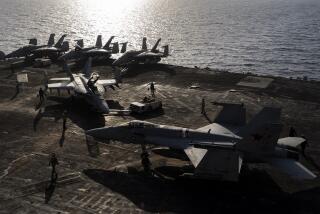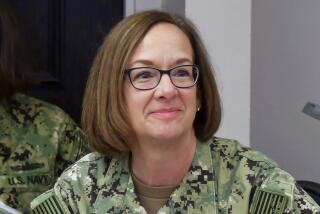Admiral Guides Fleet Into Era of Lean Budgets
- Share via
In an effort to adhere to a lean budget while running a Navy that treats its people well, the commander of the Pacific Fleet said he would prefer to close a base or mothball a ship rather than bleed every base.
“We can’t afford to hold the horizontal spread of cuts any more--taking a little bit out of every base,” Adm. Charles R. Larson said Tuesday.
In balancing the Navy’s commitments and its books, Larson said, “it’s very important that we . . . not take it out of the hide of our people.”
Larson, 53, who assumed his duties Feb. 15, covered a wide range of topics during a press conference at North Island Naval Air Station. In his new position, he rules the world’s largest naval command, which includes 259 ships, 2,000 aircraft and about 283,000 sailors and Marines, and a region that covers 102 million square miles from the West Coast of the United States to the east coast of Africa, from the North Pole to the South Pole.
He also gains his command at a time when base closings are being considered as the Cold War thaws and the Pentagon works on a 1991 budget blueprint. San Diego-area bases are not now considered as candidates for closings.
Asked about his intentions for basing aircraft carriers--nuclear and conventionally powered ones--Larson declined to offer much hope of San Diego gaining another carrier in the months ahead.
“I don’t see anything coming in the near future,” Larson said.
Only last week, Defense Secretary Dick Cheney told Japanese leaders that the aircraft carrier Independence will be transferred from San Diego to Yokosuka. For San Diego, the carrier’s new assignment will mean a $100-million annual loss in Navy contracts, services and payroll.
The move also means that San Diego, for the first time in more than 20 years, will have only one carrier, the Ranger, based here.
“Certainly down to one is not an ideal situation for this area,” said Larson, who added that the city would be given “serious consideration” as a candidate for stationing another aircraft carrier.
The Navy’s need for frugality and its zero-sum-gain policy will spill over to all commands, Larson said.
When officers “come forward and say, ‘I have a deficit here,’ the response has to be, ‘What are you willing to give up to trade for that?’ ” Larson said. “It’s a way of taking an innovative look at what we do and the way we do business.”
Larson, a Sioux Falls, S.D., native, entered the U.S. Naval Academy in June, 1954. First schooled as a pilot, he later trained for submarines and served on five nuclear-powered subs. Before attaining his new post, he was deputy chief of Naval Operations for Plans, Policy and Operations.
Larson replaces Adm. David Jeremiah, who was nominated by President Bush as vice chairman of the Joint Chiefs of Staff.
More to Read
Sign up for Essential California
The most important California stories and recommendations in your inbox every morning.
You may occasionally receive promotional content from the Los Angeles Times.










